One of the crucial essential issues you’ll assess to your website online is what hypertext switch protocol standing codes (or HTTP Standing Codes) exist there. Those codes will also be very advanced, steadily changing into a frightening jigsaw puzzle that should be solved sooner than different duties will also be effectively finished.
On this weblog put up, we’ll have a look at the commonest HTTP standing codes and mistakes, in addition to give an explanation for find out how to deal with them to keep away from making a large number of your website online.
What are HTTP Standing Codes?
HTTP standing codes are like transient notes from servers which are placed on most sensible of internet pages, however aren’t in reality part of them. What they’re, are messages from servers that notify you the way other requests are won by way of servers.
Mainly, each time browsers have interaction with servers, such messages are returned. Alternatively, customers won’t see them in any respect in lots of instances. However for those who personal or optimize internet sites, it’s severely essential so that you can perceive HTTP standing codes. They’re an important with regards to diagnosing and patching up quite a lot of configuration mistakes to your website online.
Aspect-note: If you wish to test the standing codes of your website online’s internet pages, plus get an in depth search engine optimization audit, you’re welcome to use SE Score’s Site Audit device.


What standing code categories are there?
Every request has HTTP server reaction knowledge that features a three-digit quantity that specifies the request’s outcome. Those reaction codes are damaged down into 5 distinct categories. Let’s temporarily undergo each and every certainly one of them:
1XX standing codes
Those are informational codes that tell purchasers that the entirety goes in line with plan. They point out that the server has won the request and is processing it, however no reaction is to be had but. 1XX standing codes normally aren’t displayed on-screen. As an alternative, they function inside codes that handiest browsers discuss with.
- 100 — Proceed: Informs the buyer to continue with the request or forget about the reaction if the request is finished.
- 101 — Switching Protocols: Despatched based on a consumer’s Improve request header, indicating the server’s protocol transfer.
- 102 — Processing: Signifies that the server is processing the request and that no reaction is to be had but.
- 103 — Early Hints: Essentially used with the Hyperlink header, permitting preloading assets whilst the server readies a reaction or reconnects to an foundation.
2XX standing codes
2XX standing codes are luck codes that point out that the request used to be won, understood, authorized and processed effectively by way of the buyer. Browsers use those standing codes internally to verify the luck and present state of requests.
- 200 — OK: Those standing codes point out that the request succeeded. The which means of “luck” relies on the HTTP manner used, equivalent to:
- GET: The useful resource has been fetched and transmitted within the message frame.
- HEAD: The illustration headers are integrated within the reaction with none message frame.
- PUT or POST: The useful resource describing the results of the motion is transmitted throughout the message frame.
- TRACE: The message frame comprises the request message as won by way of the server.
- 201 — Created: The request succeeded, and a brand new useful resource used to be created, in most cases following a POST or PUT request.
- 202 — Permitted: The request used to be won however now not acted upon. Those are appropriate in eventualities the place every other procedure or server is dealing with it, or for batch processing.
- 203 — Non-Authoritative Data: This approach the returned metadata isn’t an identical to what’s to be had from the foundation server. As an alternative, it’s sourced from an area or a third-party replica. Those are steadily used for mirrors or backups.
- 204 — No Content material: There is not any content material to ship for this request, however headers could also be helpful; the person agent can replace cached headers.
- 205 — Reset Content material: Instructs the person agent to reset the file that despatched this request.
- 206 — Partial Content material: Used when the buyer makes use of the Vary header to request just a portion of a useful resource.
- 207 — Multi-Standing: Supplies details about a couple of assets, acceptable when a couple of standing codes are appropriate.
- 208 — Already Reported: Used when the contributors of a DAV:propstat part have already been indexed and they’ll now not be integrated once more.
- 226 — IM Used: The server finished a GET request, and the reaction represents the results of instance-manipulations being implemented to the present occasion.
3XX standing codes
They’re redirection codes that merely display that the asked content material has been quickly moved to every other URL.
- 300 — More than one Possible choices: The request has a couple of imaginable responses, prompting the person or person agent to make a choice one, steadily really helpful thru HTML hyperlinks.
- 301 — Moved Completely: An enduring trade within the URL of the asked useful resource; the brand new URL is equipped within the reaction.
- 302 — Discovered: A short lived trade within the URL of the asked useful resource, with possible long term alterations; the similar URL will have to be used for long term requests.
- 303 — See Different: The server despatched this reaction to direct the buyer to get the asked useful resource at every other URL with a GET request.
- 304 — No longer Changed: Used for caching, informing the buyer that the reaction hasn’t been changed, permitting endured use of the cached model.
- 307 — Transient Redirect: The asked useful resource has quickly moved to another URL. The one distinction in comparison to the 302 Discovered reaction is that the person should now not trade the HTTP manner used.
- 308 — Everlasting Redirect: The useful resource is now completely situated at every other URL. The adaptation between this code and 301 is the person should now not trade the HTTP request manner.
4XX standing codes
4XX standing codes are consumer mistakes that sign that one thing is improper with the request. They’re steadily associated with safety problems, however will also be returned if the buyer occasions out or if the request used to be entered incorrectly.
- 400 — Dangerous Request: The server can not or is not going to procedure the request because of a consumer error, equivalent to invalid request message framing, misleading request routing, over the top measurement, and many others.
- 401 — Unauthorized: The buyer should authenticate themself to get the asked reaction.
- 403 — Forbidden: The buyer doesn’t have get admission to rights to the content material. Not like 401 Unauthorized, the buyer’s identification is understood to the server.
- 404 — No longer Discovered: The server can not to find the asked useful resource, and no redirection has been set.
- 405 — Approach No longer Allowed: The server acknowledges the request manner however does now not reinforce it for the objective useful resource.
- 406 — No longer Applicable: Despatched when the internet server, after appearing server-driven content material negotiation, fails to search out content material that meets the factors set by way of the person agent.
- 407 — Proxy Authentication Required: Very similar to 401 Unauthorized, however authentication is needed by way of a proxy.
- 408 — Request Timeout: The server timed out for the reason that consumer didn’t produce a request throughout the allocated time.
- 409 — War: Despatched when a request conflicts with the present state of the server. It presentations details about the issue so the buyer can repair and resubmit it.
- 410 — Long past: Despatched when the asked content material has been completely deleted from the server, without a forwarding deal with.
- 411 — Period Required: The server rejected the request for the reason that Content material-Period header box is undefined, and the server calls for it.
- 412 — Precondition Failed: The buyer has specified preconditions in its headers that the server fails to satisfy.
- 413 — Payload Too Huge: The buyer’s request is bigger than the server’s prohibit, and the server refuses to procedure it.
- 414 — URI Too Lengthy: The Uniform Useful resource Identifier asked by way of the buyer is longer than the server is keen to interpret.
- 415 — Unsupported Media Sort: The server rejects the request as it does now not reinforce the media structure of the asked knowledge.
- 416 — Vary No longer Satisfiable: The variety laid out in the Vary header box within the request can’t be fulfilled.
- 417 — Expectation Failed: The server can’t meet the necessities indicated by way of the Be expecting request header box.
- 421 — Misdirected Request: The request used to be directed at a server that isn’t ready to supply a reaction.
- 422 — Unprocessable Content material: The request used to be shaped accurately however may just now not be adopted as a result of semantic mistakes.
- 423 — Locked: The accessed useful resource is these days locked.
- 424 — Failed Dependency: The request failed because of failure of a prior request.
- 426 — Improve Required: The server refuses to procedure the request the use of the present protocol until the buyer upgrades to another protocol.
- 428 — Precondition Required: The foundation server calls for the request to be conditional.
- 429 — Too Many Requests: The person has despatched too many requests inside of a definite time frame.
- 431 — Request Header Fields Too Huge: The server is unwilling to procedure the request as a result of its header fields are too massive.
- 451 — Unavailable For Prison Causes: The person agent asked a useful resource that can’t be equipped legally.
5XX standing codes
Those are server mistakes that designate that the server discovered the asked internet web page, however can’t grant get admission to to it. The request is in the end not able to be processed.
- 500 — Inside Server Error: The server has encountered an unknown factor and does now not know the way to deal with it.
- 501 — No longer Applied: The server doesn’t reinforce the asked manner.
- 502 — Dangerous Gateway: The server won an invalid reaction whilst serving as a gateway to get the vital reaction for dealing with the request.
- 503 — Provider Unavailable: The server isn’t in a position to deal with the request. This steadily happens when a server is overloaded or present process upkeep.
- 504 — Gateway Timeout: This mistake reaction is given when the server is appearing as a gateway and can not get a reaction in time.
- 505 — HTTP Model No longer Supported: The HTTP model used within the request isn’t supported by way of the server.
- 506 — Variant Additionally Negotiates: The server has an inside configuration error.
- 507 — Inadequate Garage: The server can’t whole the request because it lacks garage for the vital illustration.
- 508 — Loop Detected: The server recognized a vast loop whilst dealing with the request.
- 510 — No longer Prolonged: Additional extensions to the request are required for the server to meet it.
- 511 — Community Authentication Required: Shopper authentication is had to get admission to the community.
I need to draw your consideration to the truth that now not each standing and mistake code will also be noticed, in reality, maximum of them aren’t proven to customers in any respect. Alternatively, you’ll test them by way of examining a web page by the use of your browser (Ctrl+Shift+C to open the Chrome Developer Gear in Check up on Component mode). Simply pass to the Community tab and refresh the web page to get an error code record of each and every part at the web page, together with the web page itself:
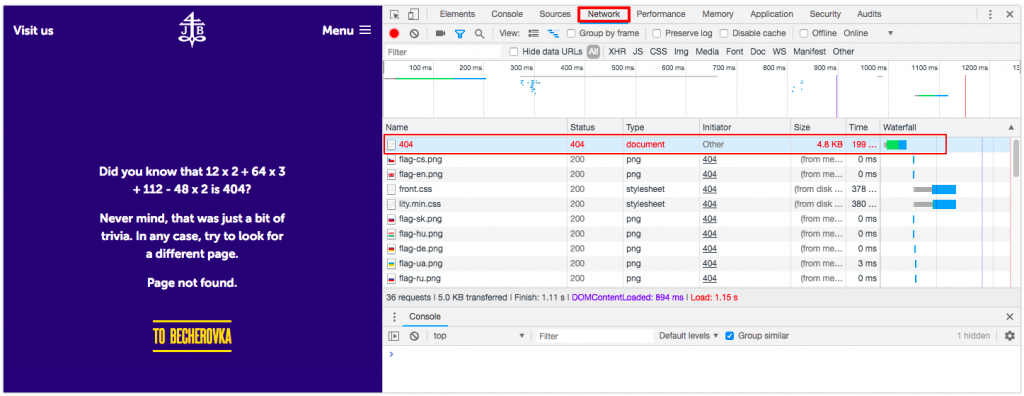

Now, let’s take an in depth have a look at the commonest server responses and the way they want to be treated.
A very powerful standing codes for SEOs
Take into account that, if you wish to know find out how to do on-page search engine optimization, get started by way of making sure that your website online is unfastened from HTTP standing code problems.
Earlier than we proceed, I need to indicate that there are greater than 40 other server standing codes, however it’s most probably that you simply received’t run into greater than a handful of them for your paintings. So, for those who’re in control of a website online and web page search engine optimization processes, it’s crucial that you realize them in order that you understand what to do whilst you’re confronted with HTTP standing code problems.
Here’s a record of the commonest HTTP reaction standing codes:
301 Standing Code — Moved Completely
The HTTP 301 Moved Completely standing code signifies that the URL asked by way of the buyer has been moved to a brand new location. Browsers practice 301 redirects with out asking customers to accomplish an motion.
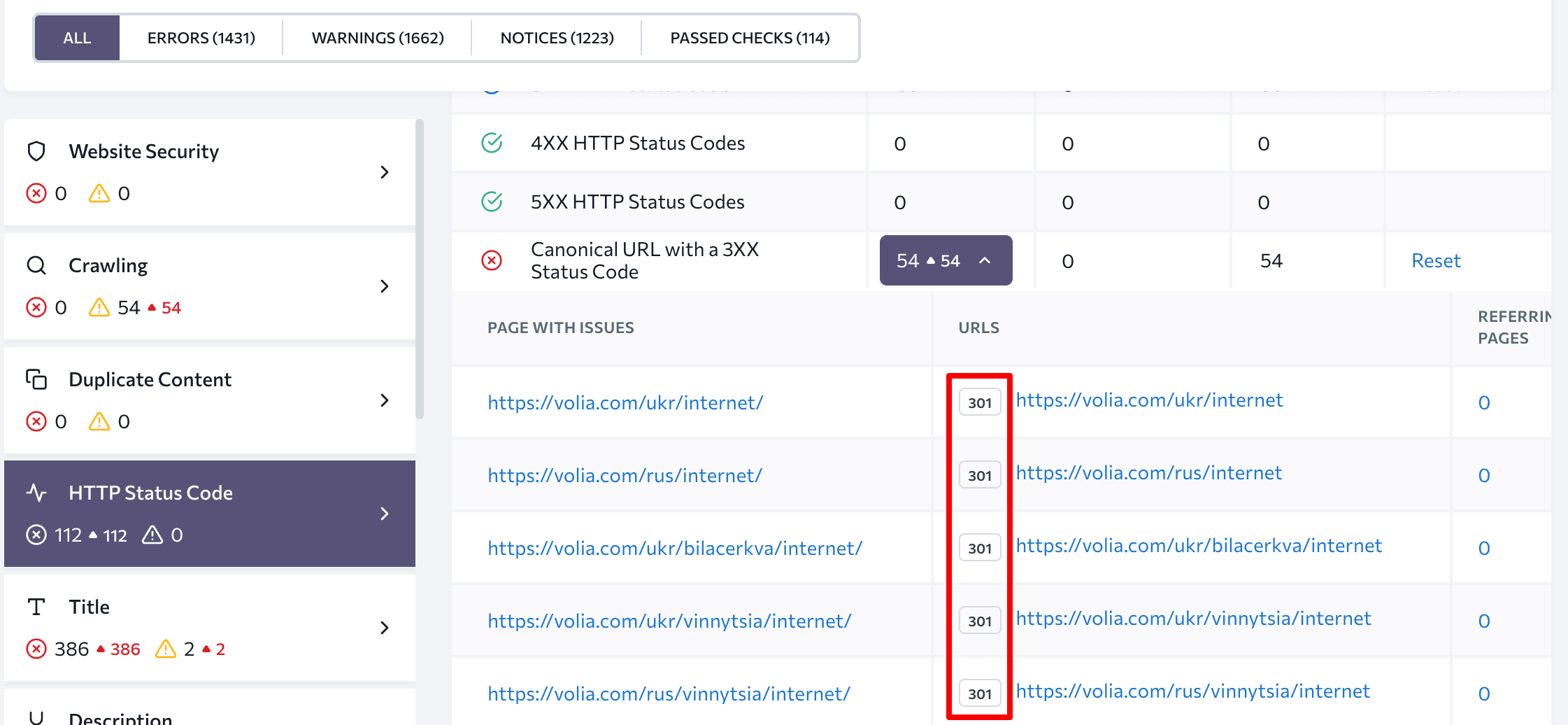

The 301 standing code is in most cases used when switching a website online from HTTP over to HTTPS, however additionally it is hired when putting in place get admission to to the website online replicate, all over URL trailing slash configuration, in addition to when shifting part of the website online or all of the website online to a brand new area.
This redirect is very really helpful in case your purpose is to switch the search engine optimization rating and authority of an outdated internet web page to a brand new one. However merely converting the URL with out updating content material can have a damaging affect at the indexation of recent adjustments. Take into accounts it: You ship a brand new sign to engines like google that you need the brand new web page to return up in seek, however for the reason that outdated URL has a large number of authority, Google doesn’t need to change it with the brand new web page.
Professional Tip: Don’t ever redirect customers from a deleted URL for your homepage. Such redirects are handled as cushy 404s by way of Google, which means that the hunt massive received’t pay any consideration to them, received’t go the PageRank or another indicators from the outdated URL to the brand new one. As an alternative, lead customers to a web page that’s very similar to the vacation spot web page.
Moreover, keep away from redirect loops as they save you customers from attending to the objective web page. In different phrases, avoid the use of hyperlink chains that come with a hyperlink that’s redirected to a URL that’s already a part of the similar chain.
It’s additionally essential now not to make use of a couple of redirects as each and every new one will lead to a rating weight reduction, and there’s a possibility Google won’t index all of the hyperlink chain.
So, simply lower out the intermediary and redirect the primary web page immediately to the remaining one you might have arrange. On most sensible of that, you’ll take away 301 redirects as time passes to cut back the server load.
302 Standing Code — Discovered
The 302 Discovered standing code is similar to the 301 code, however the 302 standing code used to be created for eventualities when a website online isn’t moved completely, however handiest quickly.


Mainly, browsers practice the 302 code routinely, and it signifies that the web page used to be effectively discovered, however it has been quickly moved to a brand new location. As a common rule, it will have to handiest be used for brief content material upkeep processes, whilst you in the end intend to take your website online guests again to the outdated internet web page.
While you arrange the 302 redirect, you inform engines like google that you simply plan on the use of the outdated URL once more someday. In consequence, the brief new web page doesn’t get any site visitors price or web page authority from the unique URL.
Professional Tip: If you happen to go away the 302 redirect in position for too lengthy, Google will finally end up treating it as though it’s a 301 redirect. Moreover, remember to test that your website online doesn’t have any 302 redirects that should be 301 as this can be a quite common mistake.
304 Standing Code — No longer Changed
The browser sees the 304 No longer Changed HTTP standing code when a internet web page is up-to-the-minute with the cached replica at the server. Necessarily, which means the web page hasn’t modified for the reason that remaining talk over with.
To elaborate, when browsers retailer knowledge of their cache, they retailer the Ultimate-Changed header knowledge as neatly. In flip, this permits browsers to understand precisely when the web page used to be remaining changed. And when engines like google have a look at the web page and notice that each header values are the similar, the server returns the 304 code.
This code can in reality be used to hurry up website online indexation. For instance, as crawlers are going thru your website online, they’ll bump into a couple of pages. And in the event that they be informed that one or a number of pages have now not been modified whatsoever, they’ll skip them, in the end, enabling extra pages to get listed.
Professional Tip: Each and every search engine optimization skilled is anticipating to peer the 200 OK standing code as a sign that the request is a hit, however the 304 standing code principally approach the similar factor. More often than not of thumb, new pages and primary web page visits will have to get the 200 code, and each next talk over with will have to produce the 304 code.
307 Standing Code — Transient Redirect
A 307 Transient Redirect standing code signifies that the asked URL has been quickly moved, and that the unique URL will have to be utilized by the person agent for long term requests.
Word that the one distinction between a 302 and a 307 standing code is that the person agent should request the brand new URL with the similar HTTP request used to request the unique URL.
Professional Tip: SEOs will have to use this standing code in the event that they want to level guests to a brand new URL, however ultimately carry them again to the unique one as soon as all the website online adjustments or updates have effectively been made. It’s very best to make use of this code whilst you don’t need to go your search engine optimization hyperlink juice from the outdated URL to a brand new one.
308 Standing Code — Everlasting Redirect
The 308 redirect standing reaction code issues out that the asked internet web page has been moved for just right to the URL this is specified within the Location headers.
What this implies is that the internet web page is now completely situated at every other URI, laid out in the Location: HTTP Reaction header. This has the similar semantics because the 301 Moved Completely HTTP reaction standing. The adaptation is that during 308s, the person agent should now not trade the HTTP manner used.
So, if a POST used to be used within the first request, a POST should be utilized in the second one request.
Professional Tip: For search engine optimization mavens, this shall we engines like google know that the internet web page and all of its assets had been completely redirected. When it comes to the hyperlink juice, it’s handed directly to the redirected web page.
403 Standing Code — Forbidden
The 403 Forbidden standing code signifies that the person doesn’t have permission to get admission to the asked internet web page. This one is lovely easy.
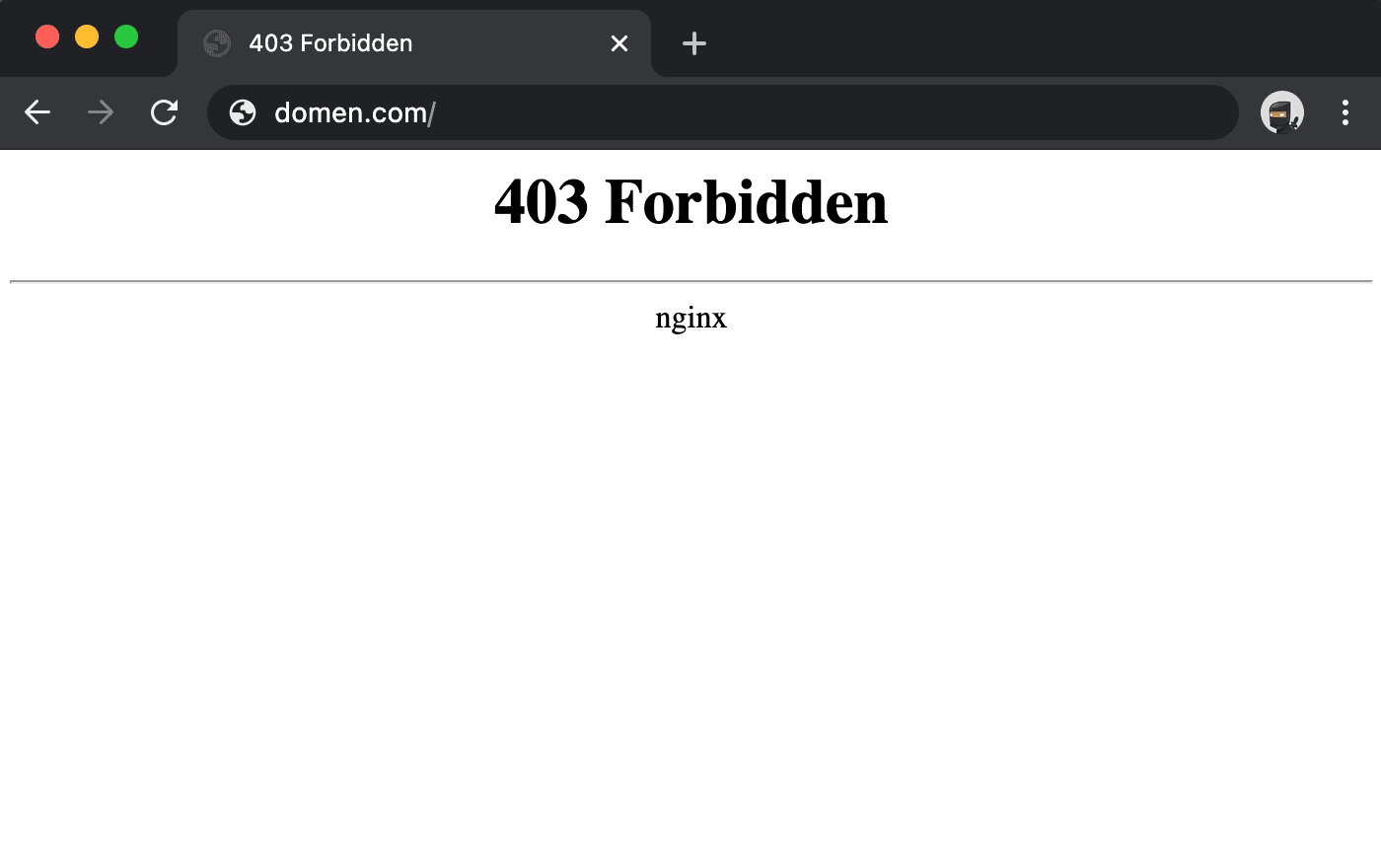

There are a number of explanation why this standing code can seem. For instance, the person is logged into the website online, however doesn’t have the vital permission to get admission to its closed-off inside community.
Different instances when the 403 standing code can seem come with eventualities when the index document for the primary web page is unsuitable. The index document will have to be referred to as “index” and feature the *.shtml, *.html, *.htm, *.phtml or *.php extensions, so remember to test that that’s the placement for your case.
Additionally, whilst you transfer over to HTTPS, the 403 standing code would possibly seem if the Area Identify Gadget (DNS) cache hasn’t been up to date but. Perfect practices counsel you wait till the cache will get up to date, but when it’s an issue of existence and demise, transparent your DNS cache in an instant.
Professional Tip: Pages that produce the 403 reaction code will in the end be got rid of from the index, which is why Google advises to make use of the 404 standing code for this as an alternative.
404 Standing Code — No longer Discovered
This is without doubt one of the maximum well known reaction standing codes in search engine optimization. The 404 No longer Discovered error signifies that the server hasn’t discovered anything else matching the asked URL, however a community connection between the server and the buyer has effectively been established.
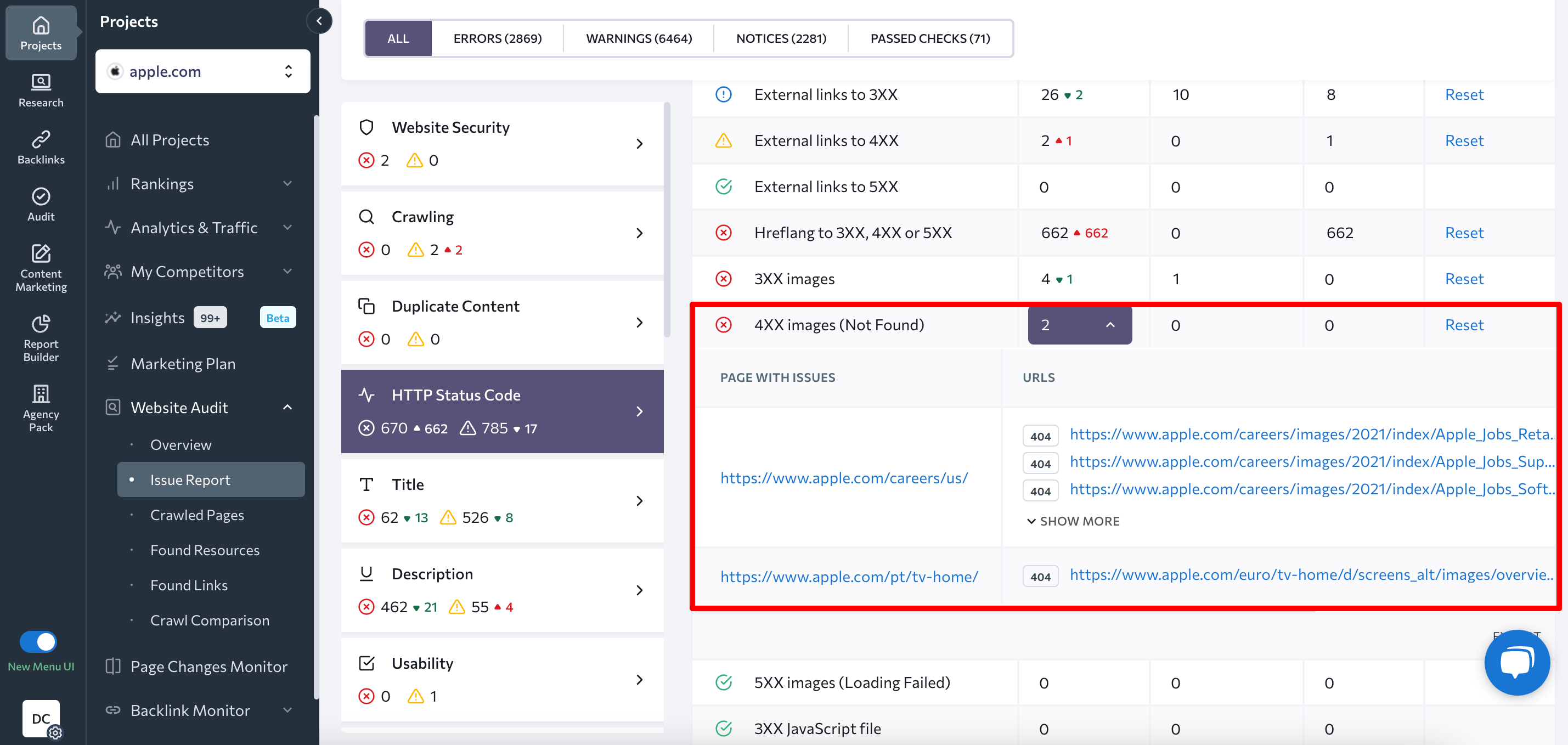

Now, don’t fear for those who see a large number of 404 pages for your Google Seek Console account. Google is just letting you understand which pages are deleted and it’s as much as you to test if the entirety’s ok. However remember to take away each hyperlink to the deleted pages out of your website online, in order that you don’t confuse guests as they navigate it.
We typically see this mistake code after we manually input a improper URL into the browser and, in consequence, attempt to get admission to a web page that doesn’t exist. Alternatively, it may possibly additionally seem if the server admin deleted a document with out first redirecting the URL to a brand new location that’s legitimate. To resolve the issue, you want to test the asked URL, repair it your self or watch for the admin to do it.
Professional Tip: Pages that show the 404 reaction code aren’t listed and don’t go any authority. This is the reason some search engine optimization mavens use a cushy 404 web page as an alternative. It returns the 200 standing code in addition to a web page notifying customers that the web page doesn’t exist. However this is regarded as dangerous observe for the reason that luck code tells Google that there’s an actual web page at that URL. In the end, the web page would possibly finally end up getting indexed in SERPs, and the hunt massive will proceed its makes an attempt to move slowly non-existent URLs as an alternative of crawling your precise pages.
Putting in place the 404 web page in your website online
The 404 web page used to appear to be a cast wall of code, however now that occasions have modified, it has transform much more inventive. Alternatively, you should take into account that customers got here for your internet web page with a selected request, and your activity isn’t simply to entertain them with cool pictures, however to lend a hand them to find what they’re in search of. So, remember to upload your website online navigation or a touch shape for your 404 pages, particularly if they’re nonetheless seeing site visitors.
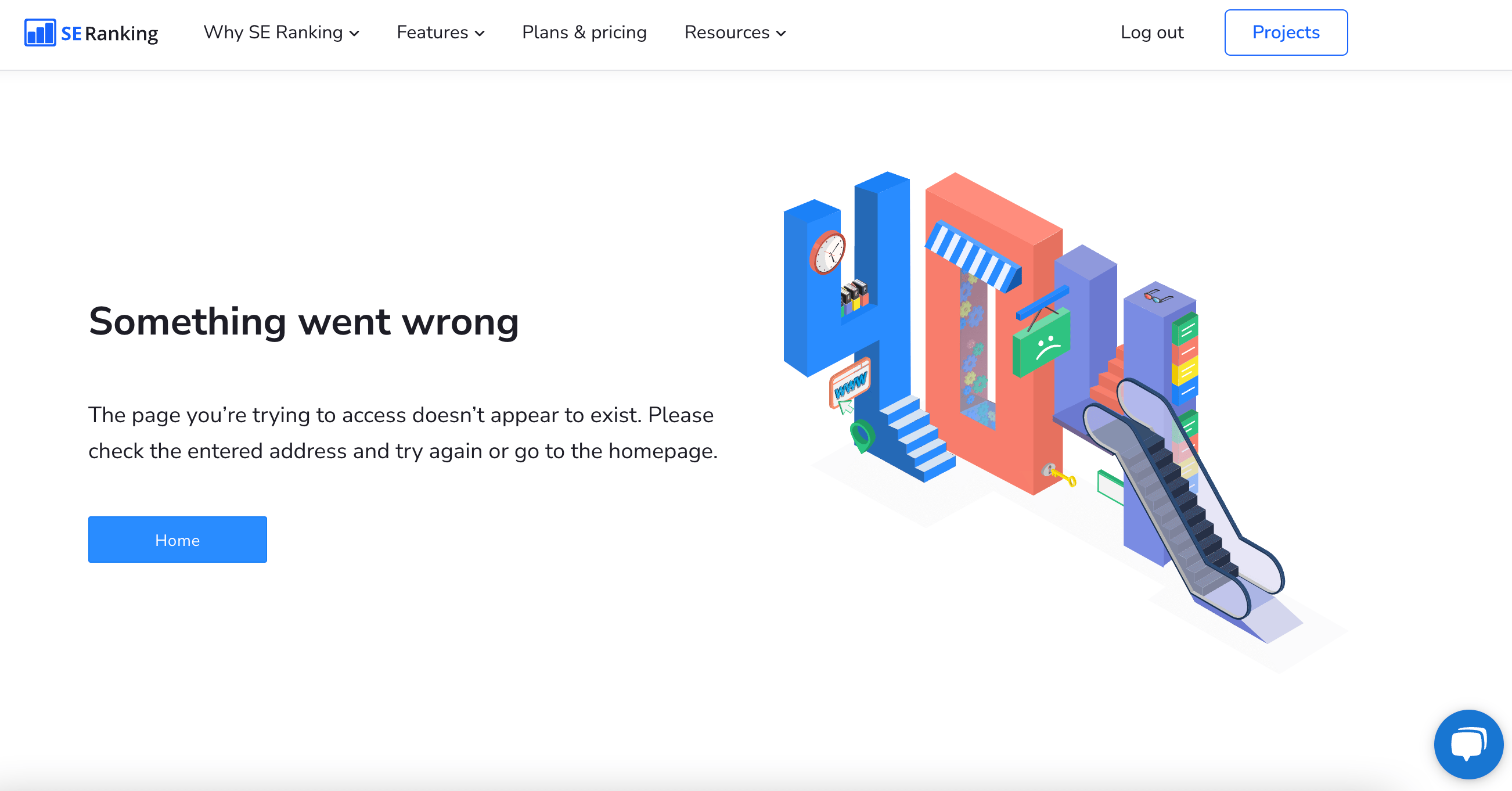

Now, in case your content material control gadget didn’t generate a 404 web page in your website online, you’ll create one your self. Right here’s how you’ll do it:
404 web page by the use of .htaccess
To arrange a 404 error web page to your website online, pass to the basis listing, open the .htaccess document (or create one if it’s lacking), and upload the next file: ‘ErrorDocument 404 /404.html’.
404 web page by the use of PHP
As for making a 404 web page by the use of PHP, in a nutshell, you’ll use the header serve as.
404 web page by the use of WordPress
You will have a number of choices with regards to making a customized 404 web page in WordPress:
- Edit the prevailing 404 web page presented by way of your theme.
- Upload a customized 404 web page in case your theme doesn’t be offering one.
- Use a 404 plugin.
You’ll be able to get all the main points on find out how to do it right here.
410 Standing Code — Long past
The 410 Long past standing code signifies that the asked website online is now not to be had at the server and no forwarding deal with is understood. And since Google’s URL Inspection Device labels 410 codes as 404 as neatly, you’ll finally end up seeing much more 404 web page mistakes for your Google Seek Console.
This standing code is in most cases used on pages that experience low consider, don’t have any hyperlinks in addition to on completely deleted ones. For instance, let’s say you now not be offering a selected provider to your website online and need to prevent using site visitors that’s in search of the non-existing web page. That is the place the 410 standing code comes into play.
Since Google doesn’t technically deal with 404 and 410 mistakes the similar manner, you’ll use a brief customized 410 web page to supply seek engine robots with a extra correct standing and knowledge that the outdated hyperlink will have to be got rid of from the move slowly index. Because of this, this will prevent the influx of needless, beside the point site visitors.
However do consider carefully sooner than completely taking down a web page. If you happen to’re now not certain, you’ll all the time arrange a redirect and nonetheless see some site visitors. Alternatively, for those who do come to a decision to fully kill a web page, be searching for hyperlinks that hyperlink out to the soon-to-be-deleted web page that may damage as soon as the web page’s got rid of.
500 Standing Code — Inside Server Error
The five hundred standing code sends a sign to browsers that there’s an inside server error that’s inflicting a website online to be inaccessible. Sadly, this standing code does now not in particular give an explanation for the explanation in the back of the mistake. Mainly, the request can’t be fulfilled.
Professional Tip: Some website online directors will in reality log such error responses as a 500 standing code containing extra details about the request to lend a hand debug the mistake and save you it from taking place once more someday.
What you’ll do is refresh the web page, test the used URL and your web connection, after which test the permissions you might have for your PHP and CGI information, in addition to generate a blank .htaccess document.
502 Standing Code — Dangerous Gateway
Each and every time you talk over with a website online, your browser sends a request to a internet server. No longer all requests are returned effectively. The 502 standing code signifies that the server won an invalid reaction from an inbound server which it has accessed whilst appearing as a gateway or proxy and making an attempt to meet the request.
Professional Tip: A foul gateway can in reality discuss with many various issues relating to networking. As an issue of reality, this isn’t an error that may simply be fastened as it calls for paintings with the internet server or the proxies you are trying to get admission to.
After ensuring you’re the use of the correct URL, transparent your browser cache, DNS flush, and speak to your host to unravel such problems to your virtual property.
503 Standing Code — Provider Unavailable
The 503 Provider Unavailable standing code signifies that the website online server is these days unavailable and, because of this, can not procedure the incoming consumer request.
Within the overwhelming majority of instances, the 503 standing code seems if the server is simply too busy, as in it’s exceeding the prohibit at the selection of concurrent customers, or if the server’s present process upkeep works.
It will also be utilized in different instances, as an example, if:
- There’s a DDOS assault at the website online,
- The website online’s the use of a large number of scripts or exterior components like widgets and photographs,
- It’s taking too lengthy to drag the asked knowledge from the database, or
- Numerous seek bots or parsing softwares make simultaneous requests.
Preferably, the 503 web page will have to comprise a message that specifies the precise time when the customer will have to come again, however that is hardly the case.
Ultimate however now not least, the 503 standing code blocks engines like google from indexing the website online. Moreover, it indicators to engines like google that the website online is poorly maintained as a result of customers can’t to find what they’re in search of. Due to this fact, it’s essential that such problems are solved as temporarily as imaginable. In a different way, it’s going to impact your total seek scores.
Putting in place the 503 web page by the use of PHP
Right here’s what the 503 standing code looks as if in PHP:
<?php header(“HTTP/1.1 503 Provider Briefly Unavailable”); header(“Standing: 503 Provider Briefly Unavailable”); header(“Retry-After: 3600”); ?>
Right here you’ll learn up about it in complete element.
Checking the server reaction with the Site Audit and solving problems
To stick on most sensible of the entirety that’s happening along with your website online, you should all the time regulate your internet pages and track their standing codes. Positive, you’ll use the Are living HTTP Headers extension for Chrome and the Index Protection record in Google Seek Console to view the standing codes of your internet pages, however it’s higher for those who spot and analyze them sooner than the various search engines do. That’s why your website online wishes an audit, and you’ll simply run one the use of SE Score’s Site Audit device.
Please be at liberty to profit from our unfastened trial to check out out all of the options.
As you scroll throughout the audit record, you’re going to see an in depth breakdown of all issues proper and improper along with your website online, together with its search engine optimization well being, web page, meta, content material and hyperlinks. The most efficient section is that you’ll simply to find out in case your website online has any pages with an sudden standing code.
Simply pass to the Crawled Pages tab to research your web page standing codes with none distractions— both immediately within the platform or by way of exporting an XLS document:
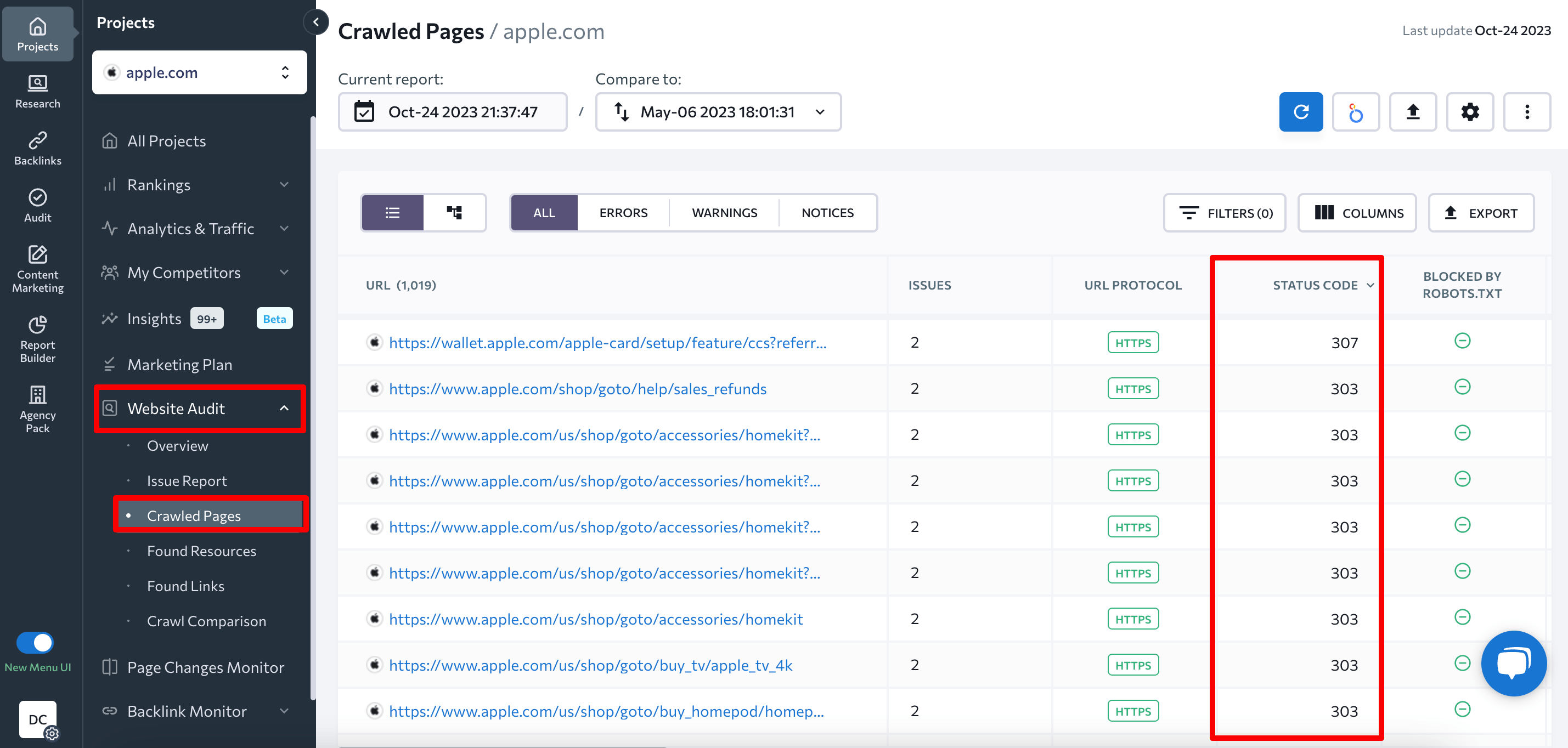

You’ll be able to additionally evaluate standing code problems at the Factor Record tab. Within the HTTP Standing Code segment, you’re going to to find quite a lot of sorts of issues and their related URLs.
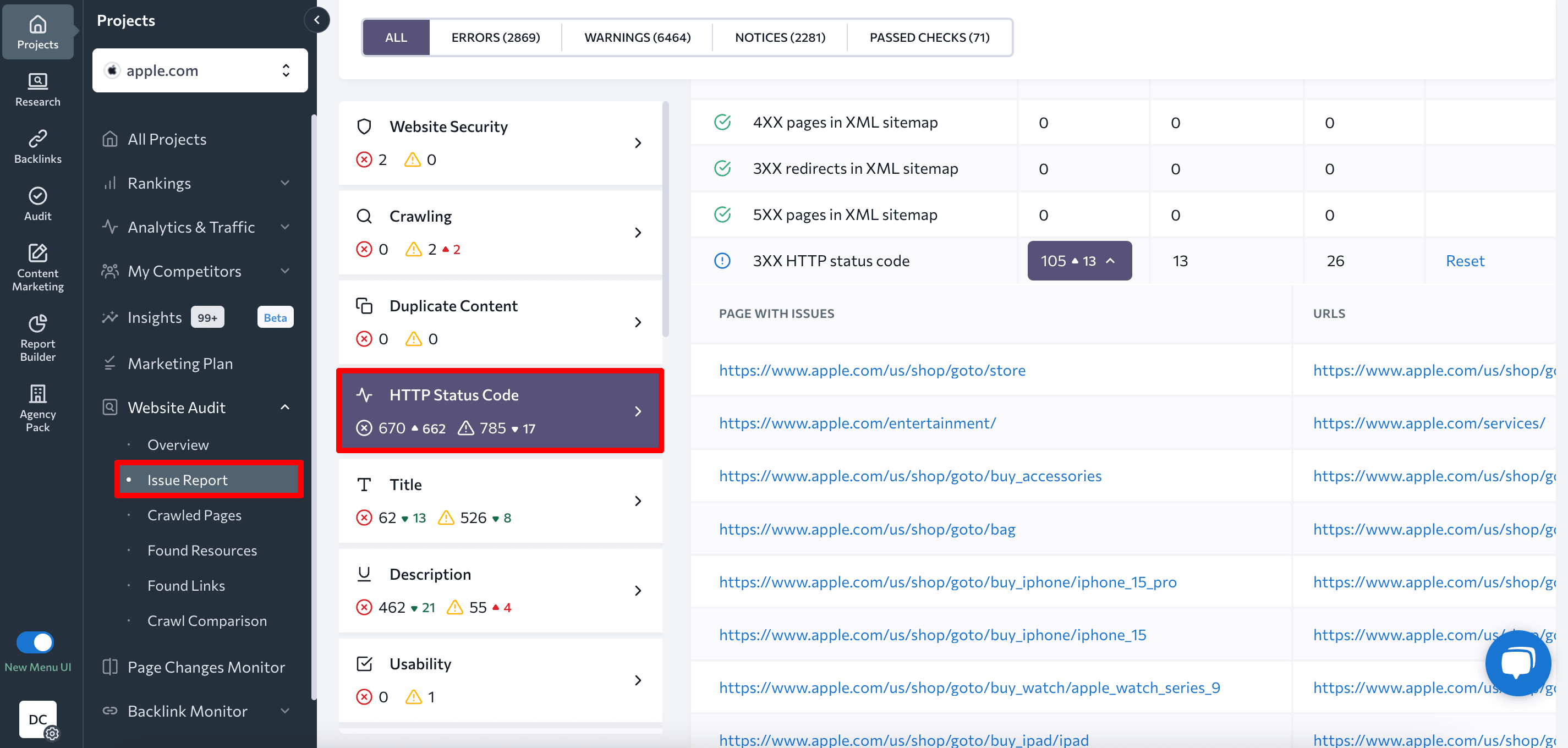

Along with having the ability to pinpoint and temporarily determine website online mistakes, the Site Audit device can generate an inventory of ideas to lend a hand search engine optimization consultants do their activity as it should be.
To deal with HTTP standing code problems, practice the steered guidelines equipped by way of the device:
Ensure the share of 3XX pages to your website online stays low. If it exceeds 10%, deal with this factor by way of doing away with needless redirects.
Take a look at your 4XX URL record and evaluate all inside pages related to them. Take away or change damaged hyperlinks with related ones that result in lively pages. For relocated or deleted pages, arrange 301 redirects.
When checking URLs with 5XX mistakes, check out reproducing the problem for your browser, and read about the server’s error log. If the issue persists, touch your website hosting supplier or internet developer. Your server could also be overloaded or misconfigured. It is also a brief factor that is going on because of server upkeep.
You’ll nonetheless must put in force the adjustments manually, however discovering them will now not be a frightening activity.
If you optimize the standing codes of your internet pages the use of the Site Audit, let Google know in order that it may possibly test and replace them for everybody to peer!
